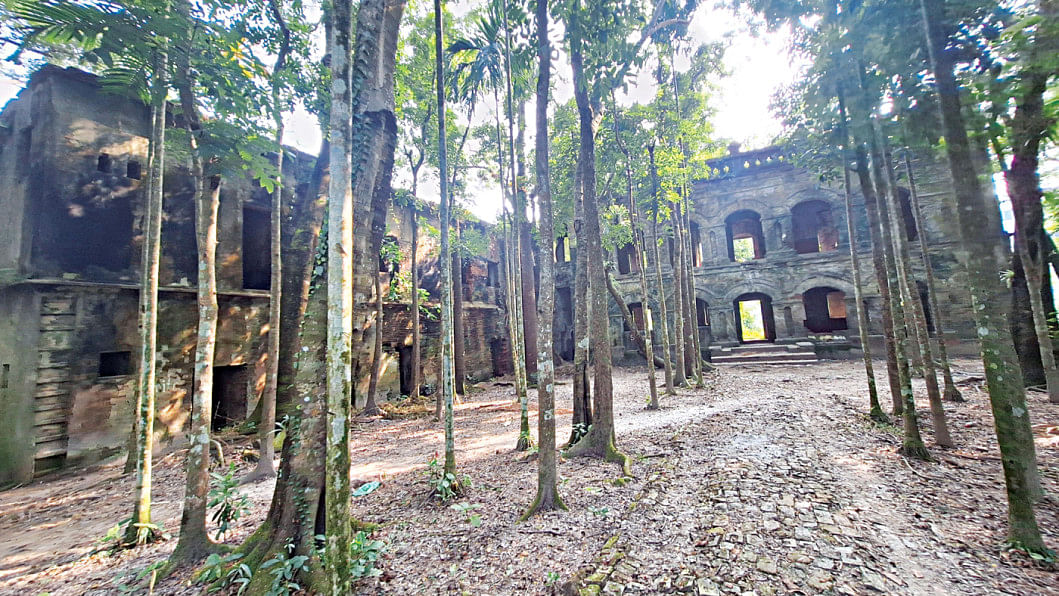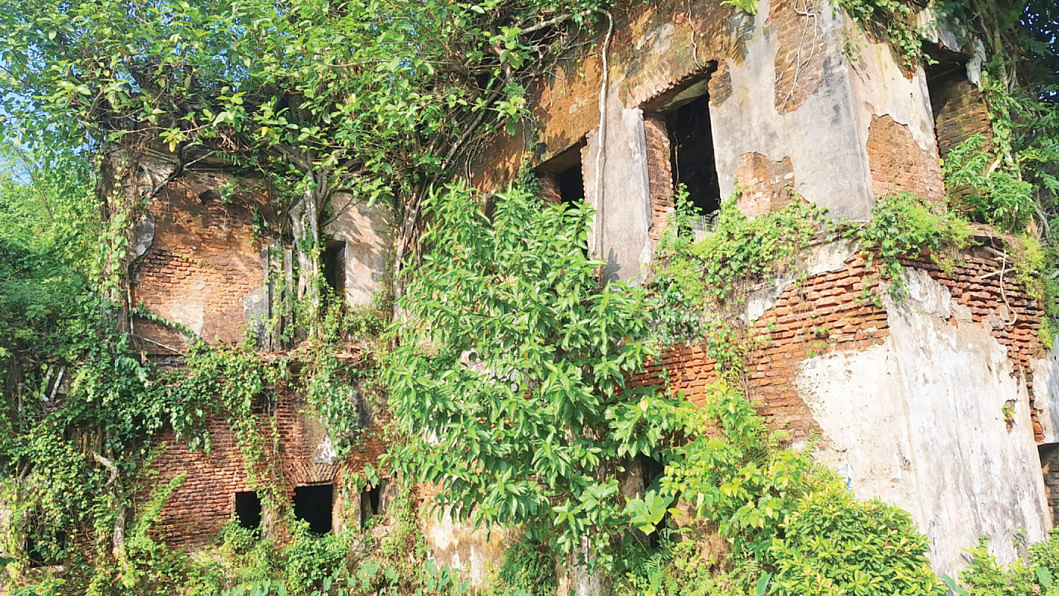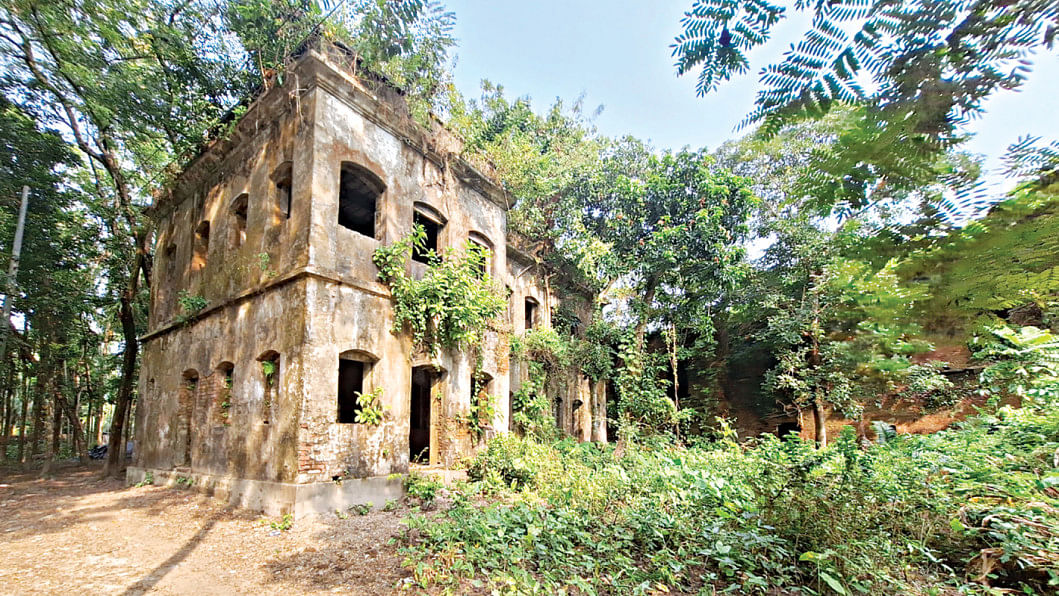Fading away in silence

Around five kilometres away from Jhalakathi district town, past the buzzing Kirtipasha bazaar and post office to the outskirts where the urban cacophony begins to fade, a colossal relic of Bengal's feudal history rises like a spectre through the foliage- the Kirtipasha Zamindar Palace.
Holding its ground for around the past two centuries, the palace now finds itself on verge of oblivion, with its ornate arches and spires cracked and decayed, wilderness gradually engulfing the estate, and its past memories of grandeur fading away silently.
Yet, to those who opt to wander inside what was once seat of power, culture, and community life in the southern region, its broken walls and forgotten shrines whisper stories of tragedy and unfinished dreams.
Tracing Back The History
Towards the late 18th century, when Krishnakumar Sen of Bikrampur was rewarded with a land granted by the Raikathi Raja in this fertile region of Barishal.
Krishnakumar eventually divided the estate among his two sons -- Rajaram Sen and Kashiram Sen -- into what locals still call the "Boro Hishya" and "Chhoto Hishya" -- the greater and lesser shares respectively.
Rajaram's 10 percent share, the Boro Hishya, gave rise to the sprawling mansion that now stands in ruins at the heart of the estate. It still houses an ancient Durga temple, shrines, and a Sati Daha Mandir that was built in memory of a tragic tale.
Meanwhile, Kashiram's six percent share, the Chhoto Hishya, vanished long ago.
Murder, Mourning, Memory
In a story that still stirs villagers to this day, Rajkumar Ray Chowdhury, a scion of the zamindar family, was allegedly poisoned to death. It remains an unsolved mystery -- some say the murder was over political rivalry, while others suspect a family feud behind it.
In a final act of devotion, or perhaps despair, Rajkumar's wife chose to die alongside him. The Sati Daha temple built in their honour today stands cloaked in vines and silence.
"It gives me goosebumps every time I stand there. This place is sacred, but it is crumbling due to neglect," says Prof Partha Sharma, a local resident and history enthusiast.

A Lasting Influence That Breathed Life To Community
The Zamindar family left behind a lasting influence through its contribution to uplift the local community through generations.
In 1903, the family established the Kirtipasha Prashanna Kumar Secondary School, one of the region's earliest formal institutions. Today, the estate also includes the Kalmi Kanda Nabin Chandra Girls' School, a primary school, the Jhalakathi Nursing College, and a nursing training institute, all housed in the former Zamindar quarters.
A union parishad office, post office, and parts of the local marketplace also stand on land once part of the estate.
Among the family's most famous scions were Rohini Ray Chowdhury, a noted historian, and Tapan Raychaudhuri, an Oxford academic and author of Bangalnama – which remains one of the most detailed accounts of Bengal's feudal system, much of it rooted in his own heritage.
In 2011, upon his return to his ancestral home, Tapan was conferred a reception from the villagers.
The Remnants Of A Fading Legacy
Today, even lying in ruins, every brick echoes history of the Zamindar family's fading legacy.
During a recent visit, these correspondents found the palace in a shambles. There are no signboard identifying the site. The rear wings of the house resemble haunted ruins -- broken roofs let monsoon water pour into the rooms, while doors and windows have been looted long ago. Massive trees have taken root inside the bedrooms and prayer halls. Vines creep over the outer walls as if the nature is trying to erase the site's memories.
Tapas Karmakar, a local artist, said, "We used to do workshops here, but now it's too overgrown, too dangerous. Tourists get scared. It's heartbreaking."

A Land Of Floating Guava Markets
Kirtipasha is nestled in one of southern Bangladesh's prime tourist zones.
Each year, particularly during the monsoon, thousands of visitors are drawn to the surrounding floating guava markets. Boats and dinghies carrying guavas drift through canals along the orchards, selling the fruits while offering a uniquely serene experience.
Only a few hundred yards away lies this historical landmark, forlorn and uncared for.
"If the zamindar palace was restored and promoted alongside guava tourism, this area would become a major destination," said Joyonto Acharya, a local ward member.
"We've been long been requesting for a tourism centre be established here. Nothing happened yet," he added.
The estate also holds potential to generate revenue through heritage tourism, boat rentals and souvenir sales, which could in turn empower local families while preserving its identity, said locals.
Of Grabbed Land And Legal Limbo
While the estate originally spanned across 25 acres of land, only 12 acres remain under the school authority. Significant chunks of the estate have been illegally occupied by vested groups over the years, while parts of the land were officially handed to the health department and union parishad.
"We've filed complaints, written letters, raised our voices. Still, no one takes action. Meanwhile, the school is trying to operate in half-collapsed buildings," said Sunil Baran Halder, headteacher of Kalmi Kanda Girls' School.
"The school serves 350 students amid much struggle. The old structures need repairs now and then, and we don't have the necessary funds," he added.
In 2017, a team from the Department of Archaeology visited the site, raising hopes among locals. However, no progress has been made since then.
"We had submitted a proposal for conservation, but no final approval came from Dhaka," said Arif Ahmed, assistant curator at the Barishal Divisional Museum.

Such delays are nothing new.
Across Bangladesh, heritage sites often fall prey to jurisdictional loopholes, especially without a powerful patron or immediate financial incentive, and their history fades through passage of time, said historians.
"Neglecting these estates is like erasing chapters from our national history," said Sirajuddin Ahmed, a veteran historian. "We can't understand the evolution of rural governance or colonial economics without them."
"The Kirtipasha Zamindar Palace isn't just bricks and memories, it's a key to understanding the culture, class, and conflict of southern Bengal," said historian and writer Saiful Ahsan Bulbul
"This is national heritage. If nothing is done, the entire structure may collapse within years. Are we ready to lose it?" said Gazi Zahid Hossain, convener of the local civic committee.
The guava orchards still bloom along the shimmering canals. Schoolchildren still play in the shadow of pillars built two centuries ago. However, Kirtipasha estate's legacy is on verge of oblivion, unless swift and serious steps are taken to conserve it.

 For all latest news, follow The Daily Star's Google News channel.
For all latest news, follow The Daily Star's Google News channel. 



Comments